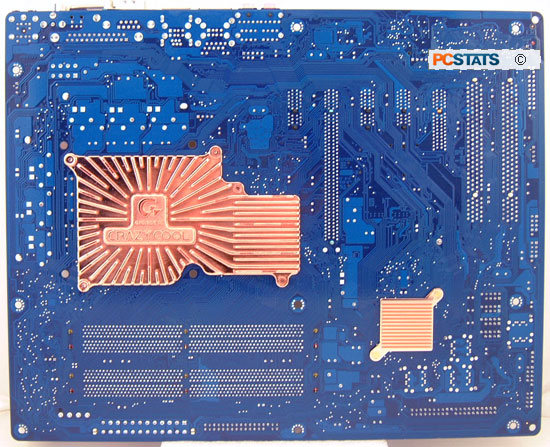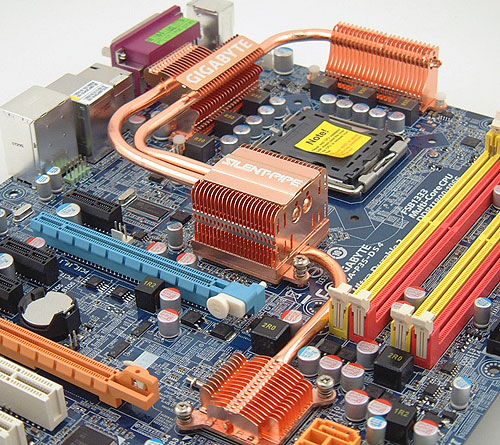Crazy Cool - Motherboard
heatsinks
In order to reduce the temperature as passively as
possible of chipsets and the CPU, Gigabyte now installs low profile aluminum
heatsinks on the backside of some motherboards, and the GA-P35-DS4. Called Crazy
Cool, the rear mounted heatsinks are located behind the Northbridge & CPU
socket, and Intel ICH9R Southbridge.
|

Much of the heat
produced by the MOSFETs, Northbridge and Southbridge is conducted through
the solder joints into the PCB, Gigabyte places a couple of heatsinks on
the back of the motherboard. Dubbed CRAZYCOOL, these heatsinks work to
keep the motherboard itself cool, which in turn lowers the temperatures of
heat-producing board mounted
components.
|
Much of the heat produced from a chipset is transferred
from the contact balls of the BGA package into the motherboard PCB, itself a
mixture of fiberglass and copper. The heatsinks are attached with screws, and a
thermal pad smooths out the bumps between the heatsink and the motherboard
PCB.
On the other side of the Gigabyte GA-P35-DS4 motherboard
is the chipset and MOSFET thermal solution called the "SilentPipe". Why you
wonder? Because it operates silently. The chipset heatsink employs copper
heatpipes and copper cooling fins that stretch across the surface of the board.
Cooling fins are located in areas where airflow from the CPU fan, or videocard
fan are likely to pass, which in the ideal situation allows the motherboard core
logic and power circuitry to remain cool without the need for additional fans.
|

The SilentPipe
adorns this snaking copper heatpipe chipset heatsink on the GA-P35-DS4
motherboard.
|
Intel's
P35 Express chipset contains upwards of 45 million transistors, and in terms of
heat output this 65nm IC is roughly on par with the P965 Express chipset - hot.
With a good motherboard level thermal solution the Intel P35 Express can be
passively cooled, silently. Crazy Cool goes under the umbrella of Ultra Durable
2, which is a collection of bits used in the making of a motherboard so it lasts
longer, and is more reliable. PCSTATS looks at this next, then it's on to
overclocking!
